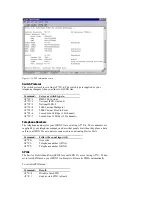
AT#Ax=2
Enable Call Waiting on the port
(default)
Three-way conference options
Each Analog Device Port’s three-way conference options can be turned on an off
using AT#Cx=. A code for three-way conferencing will be provided by your phone
company when you order the service.
Command:
Follow the equal sign with:
AT#Cx=
0, disables conference options
60, a common code used to enable the
option, is the default.. If your phone
company uses a different two-digit
number, type it after the equal sign.
Call Drop
Call Drop for each Analog Device Port
can be turned on or off using AT#Dx=.
Command:
Follow the equal sign with:
AT#Dx=
0, disables call drop
62, a common code used to enable the
option, is the default. If your phone
company uses a different two-digit
number, type it after the equal sign.
Call Forwarding
Call Forwarding for each Analog Device Port can be turned on or off using AT#Fx=.
Command:
Follow the equal sign with:
AT#Fx=
0, disables Call Forwarding
57, a common code used to enable the
option, is the default. If your phone
company uses a different two-digit
number, type it after the equal sign.
Call Transfers
The call transfer options for each Analog Device Port can be turned on or off using
AT#Tx=.
Command:
Follow the equal sign with:
AT#Tx=
0, disables call transfer
61, a common code used to enable the
option, is the default. If your phone
company uses a different two-digit
number, type it after the equal sign.
Message Waiting
The message waiting indicator for each Analog Device Port can be turned on or off
using AT#Wx=. The alert LED on your ISDN TA will flash, or there will be a stutter
dial tone on the phone if there is a message waiting.
Command:
Follow the equal sign with:
AT#Wx=
0, disables message waiting indicator
63, a common code used to enable the
















































